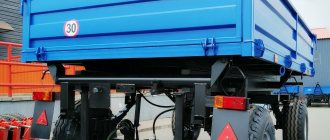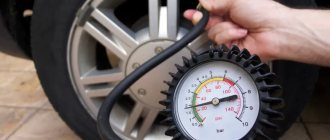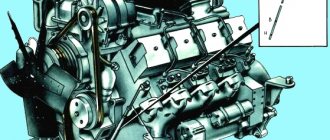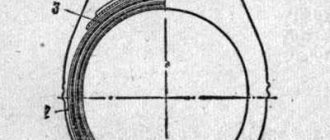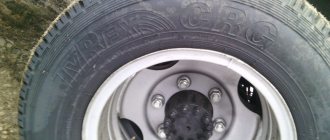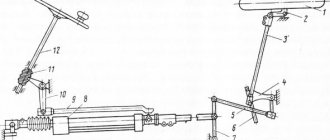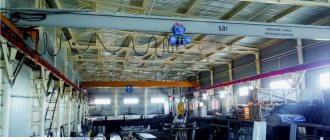Who is Pto?
VET
- this is the heart of any enterprise (organization) engaged in any technical activity.
Without a production and technical department
, the entire work of an enterprise, and not only checking technical documentation, but also planning further activities (in any industry) can slow down or, worse, stop.
Interesting materials:
Where was the Unified State Exam invented? Where did the Cossacks hide treasures? Where are iPhone backups stored on Mac? Where does China get oil? Where are crayfish caught? Where to fish in Latvia? Where is the better camera on iPhone 8 or 7 plus? Where is the best place to stay in Sochi in winter? Where is the best place to relax in autumn in Turkey? Where is it better to relax in Vityazevo or Anapa?
Technical examination of lifting structures
For all lifting structures specified in clause 3 of the FNP PS (both those registered with Rostechnadzor and those not subject to registration with Rostechnadzor) it is necessary to carry out a technical examination.
a load-lifting cranes of all types;
b overhead stacker cranes;
in pipe-laying cranes;
g cranes;
d construction lifts;
e lifts (towers) designed to move people, people and cargo (lifts with working platforms);
g electric freight trolleys moving along elevated rail tracks together with a control cabin;
h electric hoists;
and excavator cranes designed to work with a hook;
to replaceable load-handling devices and removable load-handling devices (hooks, grabs, magnets, spreaders, traverses, grippers, slings), used in conjunction with the PS for lifting and moving loads;
l containers for transporting goods, with the exception of special containers used in metallurgical production (ladles, molds), as well as special containers used in sea and river ports;
m special removable cabins and cradles, hung on the load-handling parts of cranes and used for lifting and moving people;
n rail tracks (for supporting and suspended substations moving on rails).
Scope of work, procedure and frequency of technical examination:
Lifting structures must undergo technical inspection before they are put into operation, as well as during operation. The scope of work, the procedure and frequency of technical examinations are determined by the manual (instructions) for the operation of the substation. A similar amount of work is performed during extraordinary technical examinations in cases established by the Federal Tax Service.
The static test is carried out by loading the lifting structure at 25% greater than the rated load capacity.
Dynamic testing of a lifting structure is carried out with a load 10% greater than the rated load capacity.
The purpose of the static test is to check the strength of metal structures and mechanisms of the substation. During dynamic testing, the operation of mechanisms and brakes is checked.
Useful tips
Who is a technical equipment engineer and what are his responsibilities is a question that interests many people. This is a person with a higher engineering education and special knowledge. At production enterprises he has the right:
- give tasks to subordinates;
- control their implementation;
- request necessary technical documents;
- contribute ideas to improve the organization’s work;
- demand the creation of comfortable working conditions for subordinates.
He is responsible for failure to fulfill duties, violation of labor regulations, and appearance at the workplace while intoxicated.
If you need to have a duplicate of the passport or instructions, you need to order them from the equipment manufacturer. They can also be obtained from specialized enterprises, which must first carry out a full technical diagnosis of the crane.
To carry out PHT of crane devices, it is recommended to prepare in advance a set of loads participating in the tests. Each load must be marked with its weight. During testing, the presence of someone responsible for the condition of the lifts is mandatory.
Purpose of the event
During the inspection, tests are carried out on the main parts of the crane. Tests can be static or dynamic. Their goal is to check the quality of the following systems:
- safety devices;
- control systems;
- brakes;
- alarms;
- lighting;
- hooks and other load support parts;
- ropes;
- blocks;
- boom design and its fastening;
- paths of movement of the device;
- other systems.
Inspection of cranes during static tests includes:
- checking load capacity;
- inspection of the boom structure and lifting mechanism along with the ropes.
The purpose of dynamic testing is to check the brakes. The results of all tests are entered into the crane's passport. The date of the next survey is indicated.
Safety precautions when working with lifting equipment
It is worth understanding that working with lifting mechanisms is extremely dangerous. Failure to comply with operating rules or careless attitude towards the duties of specialists who work with such equipment can lead to various unforeseen situations, including damage to the equipment itself, other property, as well as harm to human life and health. Thus, before starting to work with such devices, it is necessary to familiarize yourself with the rules for the safe operation of lifting mechanisms. In addition, it is worth considering that only persons over 18 years of age who have undergone a medical examination, special training and instruction are allowed to perform such work.
Requirements for personal protective equipment
Occupational safety requirements when operating lifting mechanisms require that employees engaged in rigging work have special protective equipment and uniforms. First of all, personal protective equipment depends on the industry and the type of cargo being handled. At the same time, there are general rules that must be followed during the work:
- when using equipment, as well as small-scale mechanization, it is necessary to wear helmets;
- when working with dusty objects, employees should wear dust-proof glasses and respirators (the filter is changed at least once per shift);
- Gloves are required to operate manual mechanisms;
- when performing manipulations with gas cylinders, you must have gas masks with you;
- you cannot work with flammable substances in synthetic workwear, as well as uniforms made of other materials that can accumulate static electric charges;
- Workwear can only be stored, disinfected, washed, and repaired in accordance with current standards.
Useful tips
Who is a technical equipment engineer and what are his responsibilities is a question that interests many people. This is a person with a higher engineering education and special knowledge. At production enterprises he has the right:
- give tasks to subordinates;
- control their implementation;
- request necessary technical documents;
- contribute ideas to improve the organization’s work;
- demand the creation of comfortable working conditions for subordinates.
https://youtube.com/watch?v=sqx5Ud9C1u4
He is responsible for failure to fulfill duties, violation of labor regulations, and appearance at the workplace while intoxicated.
If you need to have a duplicate of the passport or instructions, you need to order them from the equipment manufacturer. They can also be obtained from specialized enterprises, which must first carry out a full technical diagnosis of the crane.
To carry out PHT of crane devices, it is recommended to prepare in advance a set of loads participating in the tests. Each load must be marked with its weight. During testing, the presence of someone responsible for the condition of the lifts is mandatory.
What does the faucet plate indicate?
A crane in operation must be equipped with a sign indicating:
- registration number;
- nameplate carrying capacity;
- dates of the next partial and full technical examination.
Interesting materials:
Where did advertising first appear? Where are the 5G towers? Where can I get a certificate? Where can I get boric acid? Where can I get pure ferrite? Where can I get money to open a small business? Where can I get X? Where can I get an organization's TIN? Where can I get the Okpo code for individual entrepreneurs? Where can I get initial capital to start a business?
Terms, definitions, symbols and abbreviations
In Information Letter 03-6 of December 1963, Gosgortekhnadzor invited organizations operating self-propelled jib cranes to provide posters or inscriptions in the cabin or elsewhere warning of the dangers of working near power lines. Lifting structures (cranes) undergo two technical inspections: 1. Partial technical inspection - WHAT. The manufacturer must provide each crane produced with a metal plate indicating the name of the manufacturer, lifting capacity, production date and serial number. The technical examination is aimed at establishing that: the load-lifting crane and its installation comply with these Rules and its passport data; The crane is in a condition that ensures its safe operation.
Technical inspection of cranes can be partial or complete. During the standard service life, periodic technical inspection of cranes is carried out in the following periods: a) partial - at least once every 12 months; b) complete - at least once every 3 years, with the exception of rarely used cranes (cranes for servicing machine rooms, electrical and pumping stations, compressor units, as well as other cranes used only for equipment repairs). A full technical inspection of cranes that are classified as rarely used is carried out at least once every 5 years.
In addition to this plate, cranes in service must be clearly marked with the registration number, lifting capacity and the date of the next load test of the crane, i.e. the date of the next full technical inspection. These designations must be made in the form of large inscriptions. For overhead, mobile, cantilever, gantry, tower and portal cranes, such inscriptions must be clearly visible from the ground or floor of the workshop, for which it is recommended to use letters and numbers with a height of at least 80 mm and a width of at least 35 mm.
After replacing worn-out cargo, boom or other ropes, as well as after re-roping the ropes, the Rules require a partial inspection to be carried out to check the correctness of the reeving and the reliability of fastening the ends of the rope, as well as the wrapping of the ropes with a working (nominal) load. The purpose of the inspection is to check the condition of the crane and its mechanisms. A crane manufactured at the factory and delivered to the site of operation in assembled form must undergo a full technical examination by the manufacturer before being sent to its owner. The date of the inspection and its results must be recorded in the crane passport. Before putting the crane into operation, the owner of the crane must conduct a partial technical examination, the results of which must be entered into the passport.
Purpose of the event
During the inspection, tests are carried out on the main parts of the crane. Tests can be static or dynamic. Their goal is to check the quality of the following systems:
- safety devices;
- control systems;
- brakes;
- alarms;
- lighting;
- hooks and other load support parts;
- ropes;
- blocks;
- boom design and its fastening;
- paths of movement of the device;
- other systems.
Inspection of cranes during static tests includes:
- checking load capacity;
- inspection of the boom structure and lifting mechanism along with the ropes.
The purpose of dynamic testing is to check the brakes. The results of all tests are entered into the crane's passport. The date of the next survey is indicated.
Book: Slinger
4.1 shows the structure of supervision over the safe operation of cranes. What is the procedure for appointing a person responsible for the safe operation of cranes? Rice. 4.1. Supervision structure for the safe operation of cranes ATTENTION!
The person responsible for the safe performance of work with cranes is obliged to: · organize the work with cranes in accordance with safety rules, work design, technical conditions and technological regulations; · do not allow untrained and uncertified personnel to service the cranes, determine the required number of slingers, and
Technical inspection of cranes (PTO)
During their standard service life, cranes must undergo periodic technical inspection: 354.
The person responsible for the safe performance of work with cranes is the immediate supervisor of the slinger. What are the main responsibilities of the person responsible for the safe operation of cranes? In addition, during the technical inspection of the crane the following must be checked:
- condition of the metal structures of the crane and its welded (riveted) connections,
- as well as cabins, stairs, platforms and fences;
- condition of the hook, blocks.
359.
An extraordinary full technical examination of the crane must be carried out after: 357. During a full technical examination, the crane must be subjected to: During a partial examination, static and dynamic tests of the crane are not carried out.
362.

